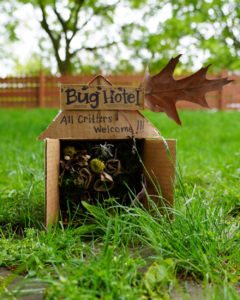There are more than 1,000 native insect species in Wisconsin and they play a huge role in the pollination process. Whether it’s actively working as a pollinator or being a nutritious meal for other native pollinators like birds, insects should be celebrated in our yards for the key role they play in the ecosystem’s health. This is why creating an insect hotel in your yard is a great way to help your local environment.
What is an insect hotel?
Much like humans, insects will need a place to stop and rest as they travel near and far playing their roles in the pollination cycle. An insect hotel gives them a perfect place to stay safe and cozy — especially over the winter! The hotels are usually created from natural materials like sticks, twigs or plant trimmings.

Three reasons you should build an insect hotel
- They attract beneficial insects. Many insects are important to the global ecosystem. Some specialize in pollination, others help reduce the population of detrimental insects and some serve as a primary source of food for other important animals.
- You have plenty of space to share. Loss of habitat is a very real and very serious challenge facing many animals, including insects. Making an insect hotel helps create a safe space for insects to live their brief — but important — lives.
- Increase your awareness and understanding of nature. An insect hotel creates a perfect environment for learning more about our ecosystem. You can learn how to identify different types of insects and see how they are beneficial to the overall health of local flora and fauna.
Getting ready for the grand opening
- Construction
- Create a simple wooden box frame and then fill it with the perfect material to attract insects! Stuff twigs, bark, grass and leaves into the hotel until it’s full — and make sure to leave plenty of small crevices for insects to hide and nest.
- Different types of materials can help attract different types of insects:
- Dead wood and loose bark for creepy crawlies like beetles, centipedes, spiders and woodlice
- Holes and small tubes for solitary bees made from paper straws, bamboo, reeds and small drilled logs
- Dry leaves, sticks or straw for ladybirds, beetles and bugs
- Corrugated cardboard for lacewings
- Other suggested items: toilet paper/paper towel tubes, dried flowers, pine cones, moss, hay, grapevines
- Finding the perfect spot
- Insects will tend to be attracted to warmth. This means the best place for your insect hotel is a south-facing wall or fence, possibly in full sunlight or with partial shade.
- Looking to book more rooms in your hotel? Try adding a water feature nearby to attract birds, bees and other insects!
- Maintenance
- Just like a hotel for humans, insect hotels will also need a little housekeeping from time to time. Every few months or so, it’s always a good idea to sweep it out and replace the materials.
- Our recommendation: Wait until the end of spring before clearing out the hotel. This gives your “guests” plenty of time to pack their bags and move on to warmer pastures.
- Just like a hotel for humans, insect hotels will also need a little housekeeping from time to time. Every few months or so, it’s always a good idea to sweep it out and replace the materials.
Read about Now Mow May for more information on how you can support local pollinators.
Special thank you to the Zoological Society’s Education department for assisting with instructions and facts!
